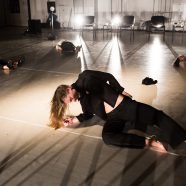Irena Tomažin Zagoričnik (SLO): MOVED BY VOICE
23. 9., 22:00, performance (60′) @ French pavilion
The performance Moved by Voice by Irena Tomažin Zagoričnik continues her exploration of the relation between the body, voice, and space. Tomažin and her collaborators undertake a research into the multiple sources of voice, its flesh, its materiality and metaphysical properties, and scrutinize its meaning and place in everyday life. This is an investigation of the processes that take place when the will of the cultivated flesh slackens and permits the presence of the voice, disburdened of the dichotomy between subject and object, culture and nature, the individual and the social, between the vulnerable body and the power of performance, to grow out of the cautious and delicate space/flesh.
Irena Tomažin Zagoričnik graduated from philosophy at the Faculty of Arts in Ljubljana, Slovenia. She is active in the fields of theatre and performance as well as in experimental improvised music.
Concept: Irena Tomažin Zagoričnik
Co-created and performed by: Adriana Josipović, Nika Rozman, Irena Tomažin Zagoričnik, Nataša Živković
Dramaturgy: Barbara Korun
Sound space: Tomaž Grom
Light design: Urška Vohar
Costumes: Mateja Fajt
Design and photography: Hanna Juta Kozar / Tomaž Šantl
Executive producer: Sabina Potočki
Production: EMANAT
Co-production: Sploh
Partner: Bunker/SMEEL
Financial support: Slovenian Ministry of Culture, Ljubljana County
1.What would you say Goodbyeto in the social and political context of your own city and country?
I would say goodbye to the hatred speech, of course, on all the levels and in general but also towards the culture and art itself; lately the selfemployed artist, artistic venues and festivals are seen as parasites on the state’s or city’s finances and as unnecessary expense, and economic crisis was all the time the proper excuse how to grow in society’s mind that culture and art are not just necessary but a waste. But the worse is that culture and art are all the time though and measured in monetary, financial vocabulary. To this is connected the fear towards anything new, unknown, towards anything that needs at least a bit of engagement towards understanding and educating and in this sense the problems we deal in cultural and artistic scenes are the problems needed to be applied on the level of basic education already in primary schools – but there they don’t even want to hear anything about contemporary art. The other thing would be the dispersion of the work formed only in the single projects with no real possibility of continuous work. Yes, projects are important and necessary, but they are becoming shorter and poorer in the process itself and this is based again on budget – not just for the projects themselves but also for the venues, studios, theaters.
2.What would you say are good (positive) practices of cultural politics in your city and country? What impact did the implementation of these practices had on the cultural scene in your city and country?
One of the positive practises are, for sure, the status of self-employed artists which helped the artists and cultural workers become visible also on the field of employment and with this connected the basic rights as workers (recognized “years of service and covered basic health and pension expenses”). One of the consequences and for me the most important is the connection between artists, cultural workers themselves and building of community that is much more beneficial when it comes to the articulation and the constant fight for basic rights as workers in general have in Slovenia. In last years the Asociacija – Association of Arts and Culture NGOs and Freelancers makes important work for our voices to be heard in society and somehow it works as a syndicate for artist, NGOs and freelancers.

